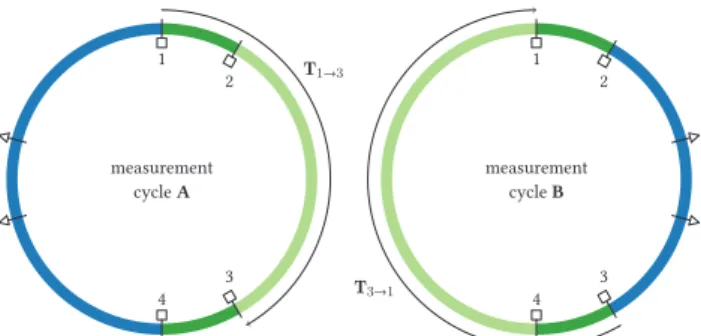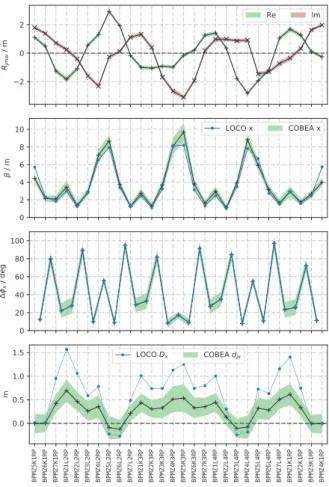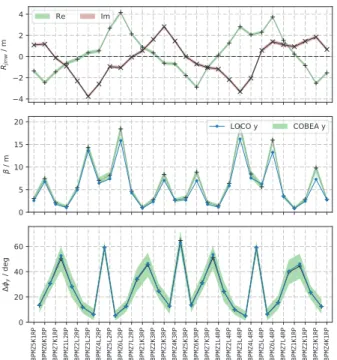COBEA - OPTICAL PARAMETERS FROM RESPONSE MATRICES WITHOUT KNOWLEDGE OF MAGNET STRENGTHS
B. Riemann, S. Koetter, S. Khan, T. Weis,
Zentrum für Synchrotronstrahlung (DELTA), TU Dortmund, 44227 Dortmund, Germany
Abstract
This paper presents some results of Closed-Orbit Bilinear- Exponential Analysis (COBEA), an algorithm designed to decompose (coupled) response matrices into betatron tunes and other optical parameters at beam position monitor and corrector positions. The only additional information strictly required by the algorithm is the ordering of monitors and correctors along the storage ring beam path. The presented method is largely lattice-independent, as no magnet strengths or dimensions are needed, and converges in a reasonable time interval due to usage of gradient-based optimization.
After describing key features of the algorithm, a set of COBEA results is compared to LOCO results for the storage rings of MLS and BESSY II. The paper is concluded by a brief discussion of further applications, limits and further development of the COBEA algorithm.
INTRODUCTION
It is known for a long time that orbit perturbations and parameters of beam optics are closely related, and several methods like [1–4], to name a few, exist to convert perturbed orbits in storage rings into beam-optical information. The presented approach aims at reconstruction of beam optical parameters with a minimal set of assumptions, so that no magnetic lattice model [1] is required. The main input to the presented algorithm, an orbit response matrixr, can be obtained by standard beam position monitors (BPMs) and correctors; the remaining inputs are either available without measurement (topology) or optional (drift space of known length to normalize optical parameters). An implementation of the algorithm is available [5].
THEORY
In the presented approach, the concept of complex eigenor- bits is used, which is based on eigenvectors of one-turn transfer matrices. This paper describes examples for the decoupled response matrices, while a natural inclusion of arbitrarily coupled transverse optics is possible [5, 6]. For the decoupled case, the response matrixris represented by the Bilinear-Exponential model with dispersion [6] for one mode
rmodeljk =
Rje−iSj kμ/2A∗k
+djbk. (1)
withRj ∝
β(sj)eiφ(sj)parameterizing optical functions at BPM positionssj,Akrepresenting beam optics at corrector positions ˜sk, and the topology matrixSjk =sign(sj−s˜k) ∈ {−1,1}. This topology matrix can be computed from simple
knowledge of theorderin which BPMs and corrector mag- nets are installed along the beampath (no lengths required).
Furthermore, μ = 2πQrepresents the fractional betatron tune,dj is proportional to the dispersion orbit atsj, andbk
to dispersion coupling of the correctork.
The goal is to find all of the above optical parameters Rj,Ak, μ,dj,bk so that (1) is an optimal fit for a measured response matrixr, with the additional input being the topol- ogy matrix.
The presented approach consists of two separate steps. In the first step, one tries to find approximate values for the parameters in question. In the second step, these parameters are optimized until a convergence criterion is reached.
Step 1: Splitting the ring
To obtain start values, one imagines the storage ring of being composed of two linac-like segments, extending clock- wise from BPM 1 to 3 and back from BPM 3 to 1; their ends being connected by two doublets of BPMs (see Fig. 1). One can obtain maps from one BPM doublet space(x1,x2)Tto the other and vice versa, construct a one-turn matrix, and findR1,R2andμby its eigendecomposition [6]. For this to work, no transfer map has to be known in advance - one only needs to make sure that correctors are located outside of the mapped segment (usingSjk).
measurement cycleA
1 2
4 3
T1→3
measurement cycleB
1 2
4 3
T3→1
Figure 1: Doublet (dark green) maps for the two linac-like segments (green) are found using outside correctors (blue).
Knowing these parameters, one is able to compute allAk
and allRj from them using Corrector-Monitor mapping [6]
with the response matrix elements as input. This mapping had previously been explored for use with turn-by-turn data [7], but is now completely independent of it. Start values for dispersion are created using Singular Value Decomposition [8] on the remaining deviations [6]
The complete procedure is called Monitor-Corrector Sub- space (MCS) algorithm [6]. As no special requirements were stated for the two BPM doublets, they can be chosen almost MOPIK066 Proceedings of IPAC2017, Copenhagen, Denmark
ISBN 978-3-95450-182-3 676
Copyright©2017CC-BY-3.0andbytherespectiveauthors
05 Beam Dynamics and Electromagnetic Fields D01 Beam Optics - Lattices, Correction Schemes, Transport
arbitrarily in the ring, and testing multiple combinations can increase the accuracy of the start values [6].
Step 2: Optimizing the solution
Up to this point, all model parameters depend on the ac- curacy of only four BPMs. In addition, the MCS layer treats the dispersion terms as perturbations. To further optimize the solution, it is reformulated into a non-linear regression problem between measured responses and the model (1)
χ2 =
jk
rjk−rmodeljk 2
.
As this model does not require numerical tracking, one can derive an analyticalexpression for the Jacobian and gradient of χ2 [6]; this enormously accelerates the used optimization procedure [9, 10]. Optimal parameters for all optical parameters of the model are obtained. These can be converted to other parameterizations including fit errors; the full betatron tune can also be obtained by further computa- tions [6].
APPLICATION TO MEASUREMENTS
A revised Python implementation of the COBEA algo- rithm is available [5]. This code is used in the following to re-evaluate some results obtained in [6]. The response matri- ces and LOCO [1] comparison data for the storage rings of MLS and BESSY II were generously provided by colleagues of Helmholtz-Zentrum Berlin (HZB) [11].
In the present evaluation, the vertical (y) plane matrices are analyzed without considering dispersion; this is different to [6] and increases accuracy for the dispersion-free case;
other minor modifications which may slightly influence the result parameters within error margins have also been made for the MCS layer .
All matrices analysed in the following are decoupled in the sense of (1), although COBEA is also able to decompose transversely coupled response matrices as was already shown using the DELTA storage ring [6]. Also, a drift space of known length was given as input for normalizingβvalues [6, 11]. Please note that COBEA can only represent the dispersion orbit up to a constant factor (bilinear term).
To judge the result by simple means, a fit quality F is defined by
F2= 1 χ2
jk
r2jk.
Analysis for Metrology Light Source data
The electron storage ring of the Metrology Light Source (MLS) has a circumference of 48 m and maximum energy of 630 MeV [12]. Input and comparison data for 28 BPMs (transverse), 12 horizontal correctors and 16 vertical cor- rectors was provided [11]. COBEA application in the hor- izontal (x) plane results in a fit quality F = 123.7, a re- sult obtained in≈ 10 s on a typical PC due to the small
matrix size. COBEA’s estimate for the horizontal tune is Q=3.178±0.007, which coincides with LOCO’s estimate of 3.178. Optical results for BPMs for the horizontal plane are shown in Fig. 2 in comparison with LOCO results.
Figure 2: Analysis of BPM optics parametersRj with con- version to Courant-Synder parameters, and dispersiondjfor MLS horizontal plane in comparison with LOCO predic- tions.
For the vertical (y) plane, we obtain a fit quality ofF = 112.5 and a tuneQ=2.231±0.005, where LOCO predicts 2.239. The optical results are shown in Fig. 3.
Analysis for BESSY II data
The BESSY II synchrotron light source includes a storage ring with a nominal beam energy of 1.7 GeV and a circum- ference of 240 m [13]. Input and comparison data from 108 BPMs, 80 horizontal correctors and 64 vertical correctors was provided [11]. Data from a non-functional BPM known from previous analysis in [6] was removed.
The fit quality wasF=215.7 with a tune ofQ=17.847± 0.003 in the horizontal plane, LOCO yielding a tune 17.847, both estimates coinciding within predicted COBEA error margins. The xplane monitor results are shown in Fig. 4.
In the vertical plane, the fit quality isF =343.9 with a tune estimate ofQ=6.741±0.001, where LOCO’s prediction was 6.745.
Proceedings of IPAC2017, Copenhagen, Denmark MOPIK066
05 Beam Dynamics and Electromagnetic Fields
D01 Beam Optics - Lattices, Correction Schemes, Transport
ISBN 978-3-95450-182-3 677 Copyright©2017CC-BY-3.0andbytherespectiveauthors
Figure 3: Same as Fig. 2 for the vertical plane. For this plane, the model is chosen to neglect the dispersion term djbk.
Figure 4: Analysis of BPM optics parametersRj with con- version to Courant-Synder parameters, and dispersiondjfor BESSY IIxplane in comparison with LOCO predictions.
COMPARISON OF METHODS
Several algorithms for computation of optical parameters from measured orbits, either closed or by transient exci- tation, exist. In the following, COBEA is compared to a non-exhaustive list of such algorithms.
Linear Optics from Closed Orbits
The LOCO algorithm [1] essentially fits a full magnetic lattice model to a measured response. While this also allows for evaluation of optical functions continously along the ring, it is built on all assumptions inherent in the used lattice model and selection of its dependent variables for optimization.
In contrast, COBEA uses a minimal, non-arbitrary set of assumptions in its closed-orbit model, which gradient can be evaluated without numerical tracking.
Fast Phase Determination
The fast phase determination technique [2] has been found to be a distant relative to the presented approach. However, this technique posesses no start-value layer like the MCS algorithm, and thus depends on proper initial values which are typically provided from an existing lattice model. Its (projection-based) optimization procedure is polar-bilinear, and can thus not optimize betatron tunes. Also, dispersive effects are neglected, and the input matrices must be trans- versely decoupled.
Model-Independent Analysis
In the following, MIA is discussed in its use on turn-by- turn BPM input data from storage rings [3]. By its statistical nature, MIA (in its basic implementation) is fully indepen- dent of a lattice model, including BPM-corrector order. This increased flexibility comes at the price of full dependence on turn-by-turn capable BPMs, additional hardware that is not or only partially available at a large number of storage rings.
CONCLUSION AND OUTLOOK
It has been demonstrated that COBEA can be used to decompose response matrices into optical parameters, given the ordering of the respective BPMs and correctors along the beam path as additional information [6]. COBEA can in principle also be used to clean measured response ma- trices from noise [6, 14], and the use of its model for orbit correction is investigated [14].
With COBEA being available [5], we hope to contribute a useful tool to obtain optical parameters from response matrices at other storage rings.
ACKNOWLEDGMENTS
The authors want to thank all colleagues at HZB in- volved in response matrix recording and data transmission so far [11], B. Isbarn, M. Sommer, P. Hartmann, D. Schirmer, G. Schmidt, P. Towalski, G. Schünemann, R. Molo, N. Lock- mann, C. Mai, A. Meyer auf der Heide and the complete ac- MOPIK066 Proceedings of IPAC2017, Copenhagen, Denmark
ISBN 978-3-95450-182-3 678
Copyright©2017CC-BY-3.0andbytherespectiveauthors
05 Beam Dynamics and Electromagnetic Fields D01 Beam Optics - Lattices, Correction Schemes, Transport
celerator team at DELTA, as well as M. Boege and A. Streun from PSI for valuable suggestions.
REFERENCES
[1] J. Safranek, “Experimental determination of storage ring optics using orbit response measurements”, Nucl. Instr. Meth.
Phys. Res. A388(1–2), pp. 27–36, 1997.http://dx.doi.
org/10.1016/S0168-9002(97)00309-4
[2] G. Hoffstaetter et al., “Orbit-Response Matrix Analysis at HERA”, in Proc. EPAC 2002, Paris/France, paper MOPLE041, 2002. http://inspirehep.net/record/
590289
[3] C.-x. Wang, “Model-Independent Analysis of Beam Centroid Dynamics in Accelerators”, Ph.D. dissertation, Stanford Uni- versity, 1999.http://inspirehep.net/record/517307 [4] R. Tomas, “Direct Measurement of Resonance Driving Terms in the Super Proton Synchrotron (SPS) of CERN using Beam Position Monitors”, Ph.D. thesis, University of Valencia, 2003.http://cds.cern.ch/record/615164
[5] cobeamodule for Python 2.7, software available at https://bitbucket.org/b-riemann/cobea
[6] B. Riemann, “The Bilinear-Exponential Closed-Orbit Model and its Application to Storage Ring Beam Diagnostics”, Ph.D.
Dissertation, TU Dortmund University, 2016.http://dx.
doi.org/10.17877/DE290R-17221
[7] B. Riemann, A. Ferrarotto et al., “Two General Orbit Theorems for Efficient Measurements of Beam Optics”, in Proc. IPAC’15, Richmond/USA, paper MOPWA035, 2015. http://accelconf.web.cern.ch/AccelConf/
IPAC2015/papers/mopwa035.pdf
[8] G. Golub and S. Kahan, “Calculating the Singular Values and Pseudo-Inverse of a Matrix”, SIAM J. Numer. Anal. B 2(2), pp. 205–224, 1964.http://dx.doi.org/10.1137/
0702016
[9] D.C. Liu and J. Nocedal, “On the Limited Memory Method for Large Scale Optimization”, Math. Prog. B45(3), pp. 503–
528, 1989.http://dx.doi.org/10.1007/BF01589116
[10] C. Zhu, R.H. Byrd and J. Nocedal, “Algorithm 778: L-BFGS- B: Fortran subroutines for large-scale bound-constrained opti- mization”, ACM Trans. Math. Software23(4), pp. 550–560, 1997.http://dx.doi.org/10.1145/279232.279236
[11] M. Ruprecht, D. Engel, A. Jankowiak, R. Müller, M. Ries and J. Feikes, personal communication, Helmholtz-Zentrum Berlin and TU Dortmund University, 2015–2016.
[12] J. Feikeset al., “Metrology Light Source: The first electron storage ring optimized for generating coherent THz radiation”, Phys. Rev. ST Accel. Beams14, 030705, 2011.http://dx.
doi.org/10.1103/PhysRevSTAB.14.030705
[13] A. Jankowiaket al.(ed.), “BESSY VSR, Variable pulse length Storage Ring, Upgrade of BESSY II”, Technical Report, 2015.
http://dx.doi.org/10.5442/R0001
[14] S. Koetter, B. Riemann and T. Weis, “BE-Model-Based Program for Orbit Correction”, inProc. IPAC’17, Copen- hagen/Denmark, this conference, paper MOPIK055, 2017.
Proceedings of IPAC2017, Copenhagen, Denmark MOPIK066
05 Beam Dynamics and Electromagnetic Fields
D01 Beam Optics - Lattices, Correction Schemes, Transport
ISBN 978-3-95450-182-3 679 Copyright©2017CC-BY-3.0andbytherespectiveauthors


